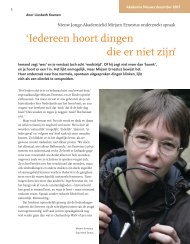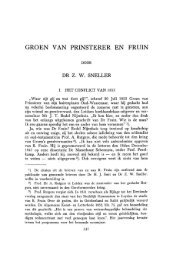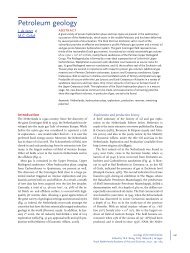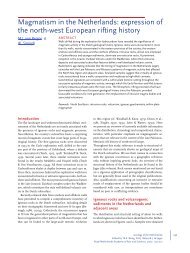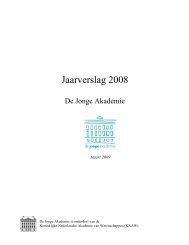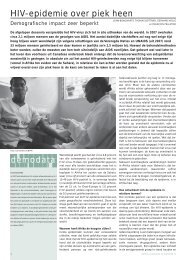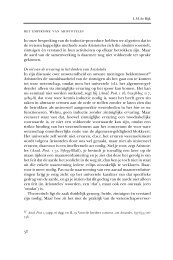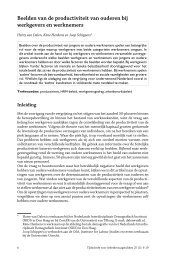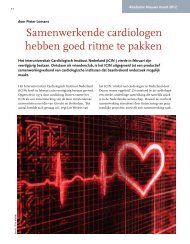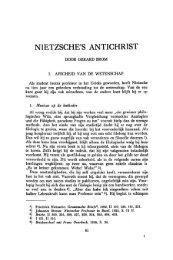Permian > M.C. Geluk > 63 - KNAW
Permian > M.C. Geluk > 63 - KNAW
Permian > M.C. Geluk > 63 - KNAW
Create successful ePaper yourself
Turn your PDF publications into a flip-book with our unique Google optimized e-Paper software.
<strong>Permian</strong><br />
M.C. <strong>Geluk</strong><br />
Introduction<br />
The <strong>Permian</strong> was deposited after the Late Carboniferous<br />
final stage of the Variscan orogeny. <strong>Permian</strong> rocks contain<br />
important hydrocarbon reservoirs and seals as well as<br />
exploitable salt deposits. In the Netherlands and the adjacent<br />
southern North Sea the <strong>Permian</strong> rests unconformably<br />
upon relatively mildly deformed Namurian to Stephanian<br />
sedimentary rocks. South-east of the Netherlands, in<br />
the area of the Variscan Mountains, <strong>Permian</strong> strata rest<br />
Fig. 1. Present-day distribution and facies map of the Upper<br />
Rotliegend Group (late Middle to early Late <strong>Permian</strong>) in the<br />
Southern <strong>Permian</strong> Basin (<strong>Geluk</strong>, 2005). BT: Bramble Trough;<br />
CNG: Central North Sea Graben; HG: Horn Graben.<br />
abstract<br />
<strong>Permian</strong> deposits in the Netherlands are represented by the Lower Rotliegend, Upper<br />
Rotliegend and Zechstein groups. The Lower Rotliegend Group (Middle <strong>Permian</strong>), of<br />
volcanic origin, is present only locally. The Upper Rotliegend and Zechstein groups, Middle<br />
to Late <strong>Permian</strong> in age and deposited under warm and arid climatic conditions, are present<br />
throughout most of the Netherlands. The Upper Rotliegend Group represents fluvial, eolian<br />
and playa-lake deposits, with the lake situated in the northern offshore area. The Zechstein<br />
Group comprises a series of marine evaporites and carbonates, which show a gradual retreat<br />
of the sea during its deposition. By the end of this deposition, continental and more humid<br />
conditions had returned. The depositional thickness of the <strong>Permian</strong> reaches almost 2000 m<br />
in the northern offshore. The regional unconformity at the base of the <strong>Permian</strong> represents in<br />
most places a hiatus of 40 to 60 Ma. The <strong>Permian</strong> deposits contain more than 95% of the<br />
large reserves of natural gas in the Netherlands; they also contain exploitable rock salt and<br />
potassium-magnesium salts. The thick layer of Zechstein rock salt deformed into a large<br />
number of salt pillows and diapirs, and strongly influenced the post-<strong>Permian</strong> structural<br />
development of the country.<br />
Keywords: Netherlands, Rotliegend, Zechstein, desert, volcanics, evaporites, salt, natural gas<br />
upon strongly deformed Paleozoic sediments (Ziegler,<br />
1990).<br />
In the Netherlands, a hiatus represents the entire Early<br />
<strong>Permian</strong>. In Middle and Late <strong>Permian</strong> times, the Netherlands<br />
became included in a large E-W trending complex<br />
of sedimentary basins, usually referred to as the<br />
Southern <strong>Permian</strong> Basin, stretching from the UK into<br />
Poland (Figs 1, 2; Ziegler, 1990; Glennie, 1997, 1998;<br />
Lokhorst, 1998; <strong>Geluk</strong>, 2005). The sedimentation area<br />
gradually expanded during the Mid and Late <strong>Permian</strong> until<br />
the London-Brabant Massif and the Rhenish Massif<br />
formed its southern, and the Mid North Sea High and<br />
Ringkøbing-Fyn High its northern margin. The Ems Low<br />
Geology of the Netherlands<br />
Edited by Th.E. Wong, D.A.J. Batjes & J. de Jager<br />
Royal Netherlands Academy of Arts and Sciences, 2007: <strong>63</strong>–83<br />
<strong>63</strong>
64 <strong>Permian</strong> > M.C. <strong>Geluk</strong><br />
Fig. 2. Present-day distribution and facies map of the<br />
Zechstein Group (Z2 Carbonate, Late <strong>Permian</strong>) in the<br />
Southern <strong>Permian</strong> Basin (after Lokhorst, 1998; Taylor, 1998;<br />
<strong>Geluk</strong>, 2005).<br />
and the Dutch Central Graben formed areas of volcanic<br />
activity during the Middle <strong>Permian</strong>, and topographic lows<br />
in Late <strong>Permian</strong> times. During the Middle <strong>Permian</strong> the<br />
differential subsidence of the future Broad Fourteens and<br />
Central Netherlands basins started. Sediment supply originated<br />
mainly from the Variscan Mountains in the south<br />
and to a minor extent also from the highs north of the<br />
basin.<br />
The depositional thickness of the <strong>Permian</strong> increases<br />
northwards from less than 50 m in the southern Netherlands<br />
to almost 2000 m in the northern offshore area.<br />
Post-<strong>Permian</strong> erosion and salt movement strongly influenced<br />
the original thickness patterns. A depth map of the<br />
base of the <strong>Permian</strong> based on well data is shown by Van<br />
Buggenum & Den Hartog Jager (this volume). The depth<br />
of the base of the Zechstein Group ranges from less than<br />
1 km in the eastern Netherlands to over 7 km in the Dutch<br />
Central Graben, and over 8 km in the Danish Central<br />
Graben and the Horn Graben (Fig. 3).<br />
Stratigraphy<br />
The <strong>Permian</strong> in the Netherlands is divided into three<br />
groups (Fig. 4; Van Adrichem Boogaert & Kouwe, 1994):<br />
Fig. 3. Depth map of the base of the Zechstein Group (in<br />
kilometres). Compiled from the geological atlas of the<br />
Netherlands (unpublished NITG compilation), with<br />
additional data from Day et al. (1981), Bailey et al. (1993),<br />
Vejbaek & Britze (1994), Kockel (1995) and Baldschuhn et al.<br />
(1996). TIJH: Texel-IJsselmeer High; MNSH: Mid North Sea<br />
High; RFH: Ringkøbing-Fyn High.
Fig. 4. Summary stratigraphy of the <strong>Permian</strong> in the<br />
Netherlands and adjacent areas (after Lokhorst, 1998;<br />
Glennie, 1998; <strong>Geluk</strong>, 1999), including a correlation with the<br />
ICS (2003) subdivision. Saalian and Altmark I, II and III refer<br />
to unconformities in the succession. In most of the<br />
Netherlands a single mega-unconformity, the Base <strong>Permian</strong><br />
Unconformity, separates the Middle to Upper <strong>Permian</strong> from<br />
the Carboniferous. Note the occurrence of two distinct<br />
volcanic pulses in time.<br />
1. the Lower Rotliegend Group, a succession of volcanic<br />
and clastic rocks with a geographically limited distribution;<br />
2. the Upper Rotliegend Group, comprising fine-grained<br />
clastics and evaporites in the northern offshore and predominantly<br />
sandstones in the onshore and western offshore<br />
area;<br />
3. the Zechstein Group, comprising marine evaporites,<br />
carbonates and subordinate clastics.<br />
The contact between the Lower Rotliegend Group and<br />
the overlying Upper Rotliegend or Zechstein groups is<br />
unconformable, whereas the contact between the Upper<br />
Rotliegend and the Zechstein Group is conformable.<br />
Traditionally the <strong>Permian</strong> deposits were subdivided into<br />
a Lower <strong>Permian</strong> Rotliegend and an Upper <strong>Permian</strong> Zechstein.<br />
Until recently, the Rotliegend was considered to represent<br />
the Early <strong>Permian</strong>, and the Zechstein the Late <strong>Permian</strong><br />
(Menning, 1995; Plein, 1995; Glennie, 1998). Radiometric<br />
dating of the Lower Rotliegend Group in Germany<br />
documents an Early <strong>Permian</strong> age (Plein, 1995; Stemmerik<br />
et al., 2000), but Middle <strong>Permian</strong> ages in the Netherlands<br />
(Sissingh, 2004; <strong>Geluk</strong>, 2005). The Upper Rotliegend<br />
Group is almost completely devoid of fossils, having<br />
been deposited under hypersaline or oxidizing conditions.<br />
Here, non-biostratigraphic tools such as chemostratigraphy,<br />
magnetostratigraphy and sequence stratigraphy are<br />
applied (George & Berry, 1994; Yang & Baumfalk, 1994;<br />
Schuurman, 1998). The Zechstein Group, especially the<br />
carbonates and claystones, yields palynomorphs and marine<br />
fossils (bryozoa, bivalves, algae).<br />
Menning (1995) published a new view on the age of<br />
the Rotliegend using paleomagnetic data. The magnetic<br />
Illawarra reversal, observed within the Upper Rotliegend<br />
in Germany, almost coincides with the boundary between<br />
the Early and Late <strong>Permian</strong>. In Germany, a thick, more<br />
complete Upper Rotliegend succession is present comprising<br />
both Early and Late <strong>Permian</strong> deposits, whereas<br />
in the Netherlands a much thinner succession comprises<br />
only Late <strong>Permian</strong> deposits (Fig. 4). The Early <strong>Permian</strong><br />
part of the Upper Rotliegend is often referred to as the<br />
Upper Rotliegend I, the Late <strong>Permian</strong> part as the Upper<br />
Rotliegend II. Various authors have adopted Menning’s<br />
view for the Netherlands and the southern North Sea (Van<br />
Adrichem Boogaert & Kouwe, 1994; Plein, 1995; Glennie,<br />
1997, 1998; <strong>Geluk</strong>, 1999, 2005). A shorter duration of the<br />
time of deposition for the Upper Rotliegend in the Netherlands<br />
than previously assumed had also been deduced by<br />
Yang & Baumfalk (1994) on the basis of high-resolution<br />
sequence stratigraphy.<br />
The <strong>Permian</strong> Stratigraphic Committee agreed upon a<br />
three-fold subdivision of the <strong>Permian</strong> (IUGS, 2000; ICS,<br />
2003). Following this subdivision, the Lower Rotliegend<br />
Group is Early to Mid <strong>Permian</strong> in age, and the hiatus between<br />
the Upper Rotliegend and the Carboniferous in the<br />
Netherlands spans the entire Early and part of the Middle<br />
<strong>Permian</strong>. The Upper Rotliegend is Middle to early Late<br />
<strong>Permian</strong>, the Zechstein Group Late <strong>Permian</strong>.<br />
A different approach to subdivision of the deposits is sequence<br />
stratigraphy, where time-lines are correlated. This<br />
results in a better understanding of the depositional relations<br />
of the sediments. Sequence-stratigraphic models<br />
of the Upper Rotliegend Group have been published by<br />
George & Berry (1994), Yang & Baumfalk (1994) and Plein<br />
Geology of the Netherlands 65
Fig. 5. Subcrop map below the Zechstein Upper Claystone Formation<br />
(after <strong>Geluk</strong> et al., 1997; Best, 1989). The present-day distribution of this<br />
formation is shown; it is absent in the grey areas. In the area of the future<br />
West Netherlands Basin the Upper Rotliegend Group (RO) subcrops below<br />
the Zechstein Upper Claystone Fm. Z1: Z1 (Werra) Fm, Z2: Z2 (Stassfurt)<br />
Fm, Z3: Z3 (Leine) Fm, Z4: Z4 (Aller) Fm, Z5: Z5 (Ohre) Fm. Z6-Z7<br />
represent the youngest evaporite cycles of the Zechstein Group identified<br />
in Germany (Best, 1989). GH: Groningen High; other abbreviations as in<br />
Fig. 3.<br />
(1995); all models propose wet-dry Milankovitch-driven<br />
climatic cycles, with a periodicity of 100 and 200 ka,<br />
to control the sedimentation. These high-resolution sequences<br />
are grouped in larger-scale cycles, with a duration<br />
of between 0.7 to 1.4 Ma. The cyclicity of the Zechstein<br />
has been described traditionally as governed by initial<br />
transgressions, followed by regressive phases with<br />
evaporite deposition (Richter-Bernburg, 1955). These cy-<br />
66 <strong>Permian</strong> > M.C. <strong>Geluk</strong><br />
cles, bounded by maximum flooding surfaces, are called<br />
genetic stratigraphic sequences (Galloway, 1989). A more<br />
modern view was published by Tucker (1991), who proposed<br />
an evaporite-carbonate sequence stratigraphy with<br />
sequence boundaries at the tops of the carbonates. The<br />
onset of the Zechstein type of cyclicity lies already in the<br />
upper part of the Rotliegend.<br />
Regional correlations<br />
The <strong>Permian</strong> in the Netherlands can be correlated without<br />
major problems to the adjacent countries (<strong>Geluk</strong>,<br />
2005). The equivalents of the volcanoclastics of the Lower<br />
Rotliegend Group are known as the Karl Formation in<br />
Denmark and the adjacent UK central North Sea (Stemmerik<br />
et al., 2000), and as the Altmark Group in Germany<br />
(Plein, 1995). Radiometric ages of these groups, however,<br />
do vary (see below).<br />
The Upper Rotliegend Group correlates with the Auk<br />
Formation in the UK central North Sea, and the Silverpit<br />
and Leman formations of the UK southern North<br />
Sea (Johnson et al., 1994). The equivalent in Germany is<br />
the Hannover Subgroup (Upper Rotliegend II of Plein,<br />
1995; Verdier, 1996); equivalents of the underlying formations<br />
do occur only in Germany and Poland (<strong>Geluk</strong>,<br />
2005). Equivalents of the Upper Rotliegend Group have<br />
been described as the so-called Zechstein conglomerate in<br />
north-east Belgium (De Craen & Swennen, 1992) and in<br />
the Lower Rhine coal-mining area in Germany (Hilden,<br />
1988). These are considered time equivalents of only the<br />
youngest Upper Rotliegend or even of the oldest Zechstein<br />
sediments.<br />
The Zechstein Group in the Netherlands correlates with<br />
the Zechstein Supergroup of the UK southern North Sea<br />
and with the German Zechstein. Most of the unit names<br />
are identical. A major discrepancy, however, affects the definition<br />
of the top of the group between the various countries.<br />
This top is picked considerably lower in the UK than<br />
in the Netherlands and Germany; as a result, rocks considered<br />
part of the <strong>Permian</strong> Zechstein in the latter two<br />
countries are assigned to the Triassic Bacton Group in<br />
the UK southern North Sea (<strong>Geluk</strong> et al., 1996; Lokhorst,<br />
1998; Fisher & Mudge, 1998; Taylor, 1998; <strong>Geluk</strong>, 1999,<br />
2005).<br />
Tectonic setting and events<br />
The deposition of the <strong>Permian</strong> followed the Variscan<br />
orogeny. The compressive movements of this orogeny<br />
ended during the Westphalian D (Ziegler, 1990). The<br />
deformation of the Carboniferous to the north of the<br />
Variscan Front in the Netherlands post-dates the Variscan<br />
folding and has been attributed to Early <strong>Permian</strong> wrenching<br />
(Van Wijhe et al., 1980; Van Wijhe, 1987; Ziegler,<br />
1990). It resulted in a major unconformity between the<br />
Upper Rotliegend and older deposits. This unconformity<br />
is referred to as the Base <strong>Permian</strong> Unconformity. In north-
Fig. 6. Model of the relationship between the subcrop at the<br />
Base <strong>Permian</strong> Unconformity and the Upper Rotliegend<br />
sandstone distribution in the north-west offshore area (<strong>Geluk</strong><br />
& Mijnlieff, 2001; <strong>Geluk</strong> et al., 2002). Sand-prone<br />
Carboniferous units (Hospital Ground Fm., Caister<br />
Sandstone) formed topographic ridges on which only thin<br />
Lower Slochteren sandstones were deposited. Fine-grained<br />
coal-bearing Carboniferous successions (Maurits Fm.)<br />
formed topographic lows, where thick Lower Slochteren<br />
sandstones accumulated. The relief was up to 25 m.<br />
ern Germany and Poland this wrenching was accompanied<br />
by widespread in- and extrusive volcanism along<br />
deep-seated fault zones. It affected the Netherlands only<br />
marginally.<br />
Several minor tectonic pulses characterize the Late <strong>Permian</strong><br />
(Gast, 1988; Plein, 1995; Glennie, 1998; <strong>Geluk</strong>,<br />
1999). These are thought to herald the <strong>Permian</strong> breakingup<br />
of Pangea (Vai, 2003). The pulses occurred prior to<br />
and during the deposition of the Upper Rotliegend Group<br />
(the Saalian and Altmark I to III pulses; Plein, 1995) and<br />
during deposition of the Zechstein (Tubantian I; <strong>Geluk</strong>,<br />
1999). As a result, a connection was established between<br />
the Southern <strong>Permian</strong> Basin and the Barents Sea. The<br />
Saalian and Altmark pulses influenced the distribution of<br />
basal Upper Rotliegend sands (Van der Baan, 1990; Van<br />
de Sande et al., 1996; NITG, 1998). The Tubantian II pulse<br />
is thought to be of compressional origin and related to the<br />
Uralian orogeny (<strong>Geluk</strong>, 2005), and marks the second, final,<br />
consolidation of Pangea at the end of the <strong>Permian</strong><br />
(Vai, 2003).<br />
There is evidence for considerable differential fault<br />
movement during the deposition of the Z1 (Werra) Formation<br />
(Wolf, 1985; Ziegler, 1989; <strong>Geluk</strong>, 1999): the<br />
Tubantian I phase. The faulting concentrated on the anhydrite<br />
platforms at the margins of the Zechstein basin.<br />
Loading of rapidly deposited anhydrite on a differentiated<br />
substrate is thought to have amplified these movements<br />
(<strong>Geluk</strong>, 1999). A series of halfgrabens and pull-apart-type<br />
basins formed, with fault offsets of up to 250 m in the Central<br />
Netherlands Basin. During this faulting the first fault–<br />
dip-closed traps of Upper Rotliegend sandstones were created,<br />
only 3 to 5 Ma after their deposition.<br />
The Tubantian II movements during deposition of the<br />
upper Zechstein are more difficult to identify. These<br />
Fig. 7. Distribution of the Lower Rotliegend Group (after<br />
Lokhorst, 1998). Volcanic activity occurred in the Ems Low<br />
and the Dutch Central Graben. Red dots indicate isolated<br />
occurrences of volcanics in wells in the German sector of the<br />
North Sea. The eastern limit of the group in the Dutch Central<br />
Graben is not well-established. From the distribution of the<br />
volcanics a bimodal pattern for deep-seated faults can be<br />
inferred.<br />
movements led to an unconformable contact between<br />
the Zechstein Upper Claystone and older Zechstein rocks<br />
(Fig. 5). They resulted mainly in tilting and uplift, and have<br />
Geology of the Netherlands 67
Fig. 8. Log correlation of the Lower and Upper Rotliegend<br />
groups, showing the transition from the sandy Slochteren<br />
Formation in the onshore area of the Netherlands into the<br />
playa of the Silverpit Formation in the northern offshore<br />
68 <strong>Permian</strong> > M.C. <strong>Geluk</strong><br />
(G17-1). The reference level is the base of the Zechstein<br />
Group. A block diagram illustrates the depositional facies of<br />
the Upper Rotliegend Group, roughly along a similar transect.<br />
ROCLA: Ameland Member.
een interpreted by <strong>Geluk</strong> (2005) as being related to mild<br />
compression. Source areas south of the basin were uplifted,<br />
and sands were shed into the basin in the western<br />
offshore area and the UK sector (Z4 or Hewett Sandstone).<br />
In the main basin a series of halites were laid down (Z6-<br />
Z7; Best, 1989), which possibly are in part redeposited<br />
Zechstein salts.<br />
Base <strong>Permian</strong> Unconformity<br />
The hiatus comprising the entire Early <strong>Permian</strong> is one<br />
of the most important unconformities in the regional petroleum<br />
geology of the southern North Sea (De Jager &<br />
<strong>Geluk</strong>, this volume). Where the Upper Rotliegend overlies<br />
Namurian to Stephanian deposits, as is the case in<br />
most of the Netherlands, this hiatus represents 40 to 60<br />
Ma. It should be taken into account that the unconformity<br />
is an amalgamation of several unconformities into<br />
a single mega-unconformity (Glennie, 1998). The name<br />
Saalian Unconformity, often used (Van Wijhe, 1987), is not<br />
correct since it refers only to one of the unconformities<br />
involved. The name Base <strong>Permian</strong> Unconformity is proposed<br />
for this mega-unconformity (<strong>Geluk</strong>, 2005; Fig. 4).<br />
Despite the large gap in sedimentation, the unconformity<br />
may be very difficult to identify in some areas, because<br />
of a similar red-bed character across this boundary<br />
and the general absence of fossils. A combination of<br />
various methods, e.g. sequence stratigraphy, core studies<br />
and chemostratigraphy, may result in a proper identification<br />
(Schuurman, 1998). The paleotopography of this unconformity<br />
affected the sediment dispersal of the basal<br />
Upper Rotliegend sandstones. The relief of this topography<br />
developed in response to resistance to weathering<br />
of the subcropping units (sand-prone Carboniferous deposits<br />
forming ridges and coal-bearing fine-grained units<br />
forming lows) and in areas close to the Variscan Front in<br />
relation to faults (<strong>Geluk</strong> & Mijnlieff, 2001; <strong>Geluk</strong> et al.,<br />
2002; Fig. 6). In areas with sufficient sand thickness in<br />
the Upper Rotliegend the effects of this topography will<br />
hardly be noticed, but they are considered critical in areas<br />
near the limit of Upper Rotliegend sandstone distribution.<br />
Lower Rotliegend Group<br />
The Lower Rotliegend Group occurs in distinct areas,<br />
namely the Ems Low, the Dutch Central Graben and the<br />
Horn Graben (Fig. 7). It is dealt with in more detail in<br />
the chapter ‘Magmatism’ (Van Bergen & Sissingh, this volume).<br />
In the Ems Low, the group is represented by the<br />
Emmen Volcanic Formation.<br />
The volcanoclastics in the Ems Low represent a western<br />
extension of a large area of volcanics in Germany (Plein,<br />
1995). They consist of red-brown to green, spilitic, basaltic<br />
volcanics, mudstones and tephra layers. Several stacked<br />
lava flows occur in the succession. The thickness of the<br />
volcanics reaches a maximum of 80 m (NITG, 2000). The<br />
Fig. 9. Isopach map of the Upper Rotliegend Group (after Lokhorst,<br />
1998). Contour interval is 100 m. Abbreviations as in Fig. 3. CNB: Central<br />
Netherlands Basin; WNB: West Netherlands Basin.<br />
group is placed in the Early <strong>Permian</strong> in Germany, based on<br />
radiometric age datings (289–291 Ma) and the lithological<br />
composition of the basalts (Plein, 1995). K/Ar ages for the<br />
Lower Rotliegend Group in the eastern Netherlands (well<br />
Drouwenermond-1), however, record a much younger volcanic<br />
pulse (Middle or Late <strong>Permian</strong>, 258±6 Ma; Sissingh,<br />
2004). This volcanic pulse correlates with the Altmark III<br />
tectonic pulse (Fig. 4), in line with the stratigraphic position<br />
of the rocks involved below the Zechstein Group or<br />
the youngest deposits of the Upper Rotliegend (Ten Boer<br />
Member; NITG, 2000).<br />
In the Dutch Central Graben the Lower Rotliegend<br />
Group reaches a thickness of almost 150 m (<strong>Geluk</strong>, 1997,<br />
Geology of the Netherlands 69
Fig. 10. Map showing the overall facies distribution at the onset of<br />
deposition of the Upper Slochteren Member (after Lokhorst, 1998).<br />
AbbreviationsasinFig.3.<br />
2005). The succession is lithologically similar to the Danish<br />
Karl Formation (<strong>Geluk</strong>, 2005). The distribution of the<br />
group is well-delineated towards the west, north and south<br />
by well data but remains uncertain to the east owing to<br />
a lack of such data. Based on the model of Stemmerik<br />
et al. (2000), the group could extend up to the margins<br />
of the graben. It consists of tephra and of up to several<br />
tens of metres thick, basaltic lava flows, interbedded with<br />
claystones and subordinate sandstones. Stemmerik et al.<br />
(2000) identify in the Danish North Sea three distinct volcanic<br />
pulses in the <strong>Permian</strong>, the first (300–288 Ma) and<br />
second phases (281–276 Ma), both of andesitic and rhyolitic<br />
composition and affecting the western part of the<br />
70 <strong>Permian</strong> > M.C. <strong>Geluk</strong><br />
Central North Sea Graben and the Horn Graben, followed<br />
by a younger, basaltic, pulse (269–261 Ma, Middle <strong>Permian</strong>)<br />
in the Danish Central Graben. Although datings<br />
from the Dutch Central Graben are lacking, it is likely that<br />
the volcaniclastics here correlate with this younger pulse.<br />
Upper Rotliegend Group<br />
The Upper Rotliegend Group consists of two formations,<br />
namely the Slochteren Formation comprising mainly<br />
sandstones and conglomerates, and the Silverpit Formation<br />
composed of claystones, siltstones and evaporites.<br />
The formations are each other’s lateral equivalents; their<br />
transition occurs in a relatively narrow zone in the north<br />
of the country (Fig. 8). The Upper Rotliegend reaches its<br />
greatest thickness, over 700 m, in the northern offshore,<br />
thinning rapidly both to the south and north (Fig. 9). The<br />
oldest sediments of the group occur in the northern offshore<br />
from where the sedimentation area gradually expanded<br />
southward (Verdier, 1996). The local absence of<br />
the group is due to post-depositional erosion on the Texel-<br />
IJsselmeer High and nearby smaller highs (Van Wijhe<br />
et al., 1980; RGD, 1991a, b, 1993; Rijkers & <strong>Geluk</strong>, 1996),<br />
and to non-deposition in most other areas (NITG, 1998;<br />
<strong>Geluk</strong>, 1999).<br />
There is strong evidence for syn-depositional fault<br />
movements in the Upper Rotliegend Group. In western<br />
parts of the Central Netherlands Basin, the thickness<br />
varies across major faults (RGD, 1993). It is likely that also<br />
the northern part of the West Netherlands Basin formed<br />
a fault-bounded depression, where up to 100-m-thick eolian<br />
sands occur, although the thickness on the Zandvoort<br />
Ridge remains uncertain (see discussion in <strong>Geluk</strong> et al.,<br />
1996: p. 61–62). Other areas where faulting occurred are<br />
the eastern Netherlands (NITG, 1998), the area north of<br />
the Texel-IJsselmeer High (RGD, 1991a, b) and the Lauwerszee<br />
Trough (RGD, 1995). Thickness variations across<br />
faults are up to 25 m.<br />
The Silverpit Formation comprises siltstones, claystones<br />
and evaporites. In the Dutch Central Graben, tephra layers<br />
occasionally occur in its lowermost part. The formation<br />
reaches a thickness of over 700 m in the northern offshore<br />
area and was deposited in a playa lake. It is subdivided<br />
into three members, the Lower and Upper Silverpit Claystone<br />
and the Silverpit Evaporite Member. The evaporites<br />
comprise mainly rock salt and subordinate anhydrite, interbedded<br />
with clay-siltstones. The individual rock-salt layers<br />
form good correlation horizons throughout the Southern<br />
<strong>Permian</strong> Basin. Their thickness reaches up to 50 m. In<br />
northern Germany and part of the adjacent Netherlands<br />
offshore these layers have been mobilized into salt pillows<br />
and in Germany even into diapirs during later geological<br />
history. The salt layers are not composed of pure halite, but<br />
contain abundant thin claystone beds. The formation interfingers<br />
southward with the Slochteren Formation; sev-
Fig. 11. Stratigraphic diagram of the Zechstein Group. In the<br />
Netherlands this group comprises five evaporite cycles<br />
(Z1-Z5) of formation rank. The Zechstein Upper Claystone<br />
Formation (ZEUC) covers these deposits unconformably. The<br />
subdivision of the formations in members reflects their<br />
dominant lithology: Z1 Carbonate, Z1 Salt, etc. (after Van<br />
Adrichem Boogaert & Kouwe, 1994).<br />
eral tongues of the Silverpit Formation reach far to the<br />
south (Ameland and Ten Boer members).<br />
The Slochteren Formation comprises conglomerates and<br />
sandstones of fluvial and eolian origin. These facies can be<br />
distinguished in cores and on dipmeter logs. Areas with<br />
predominantly eolian or fluvial deposits can be identified<br />
(Fig. 10). The fluvial systems were orientated in a S-N direction,<br />
at right angles to the basin axis. A minor clastic<br />
influx came from the Mid North Sea High. One fluvial<br />
area is situated in the western offshore, the other in the<br />
eastern onshore. Eolian deposits occur in-between these<br />
fluvial systems and to the west. Detailed studies indicate,<br />
that these facies are interbedded in a complex way, and<br />
shifted during deposition (George & Berry, 1994; Verdier,<br />
1996); rapid vertical and lateral facies alternations occur<br />
even on a metre-scale. Eolian sandstones dominate the<br />
middle part of the formation (NITG, 2000). Within the<br />
eolian deposits a further distinction can be made between<br />
dunes, which occur predominantly in the southern areas,<br />
and damp sand flats near the playa lake (Glennie, 1998).<br />
In the zone where the Slochteren and Silverpit formations<br />
interfinger, the former splits up into two main sandstone<br />
members, the Lower and Upper Slochteren, separated<br />
by clay- and siltstones of the Ameland Member.<br />
Eventually, both Slochteren members grade northward<br />
into siltstones and claystones of the Silverpit Formation.<br />
The stratigraphic position of the northernmost sandstone<br />
unit varies. It is in the Lower Slochteren north of the<br />
two fluvial systems and in the Upper Slochteren in the<br />
area in-between. Some isolated feather-edge sandstones<br />
and conglomerates have been encountered at the base of<br />
the Upper Rotliegend Group in the playa lake. Locally in<br />
Friesland and in the UK southern North Sea (Cameron<br />
et al., 1992) sandstones occur between the Ten Boer Member<br />
and the transgressive base of the Zechstein (Akkrum<br />
sandstone).<br />
Zechstein Group<br />
The Zechstein Group comprises five evaporite cycles (Z1-<br />
Z5), each of formation rank (Van Adrichem Boogaert &<br />
Kouwe, 1994). The Zechstein Upper Claystone Formation<br />
Geology of the Netherlands 71
Fig. 12. Facies and isopach map (in metres) of the Z1 (Werra) Formation.<br />
The greatest thickness, over 400 m, occurs in the anhydrite platform in the<br />
east of the Netherlands in conjunction with syn-sedimentary faulting.<br />
Rock-salt deposition occurred in the area of the Central Netherlands Basin;<br />
sandstones were shed into the basin in the western offshore (arrow). In<br />
the main basin a condensed succession of carbonates and evaporites was<br />
deposited under starved conditions (after <strong>Geluk</strong> et al., 1996, 1997; Johnson<br />
et al., 1994; Baldschuhn et al., 2001). Abbreviations as in Fig. 3; lithological<br />
symbols as in Fig. 11.<br />
covers these cycles unconformably (Fig. 11). The lithostratigraphy<br />
of the Zechstein closely approaches the concepts<br />
of genetic sequence stratigraphy (Galloway, 1989);<br />
three formation boundaries are picked on maximum<br />
flooding surfaces (base Z1: Coppershale Member; base Z3:<br />
Grey Salt Clay Member; base Z4: Red Salt Clay Member).<br />
These units form important correlation markers between<br />
72 <strong>Permian</strong> > M.C. <strong>Geluk</strong><br />
the basin and basin-fringe deposits within the Southern<br />
<strong>Permian</strong> Basin (<strong>Geluk</strong> et al., 1996, 1997; Taylor, 1998).<br />
With respect to the distribution of the Upper Rotliegend,<br />
minor overstepping of the basin margins took place during<br />
the Zechstein (<strong>Geluk</strong> et al., 1996). The depositional<br />
thickness of the Zechstein Group increases from less than<br />
50 m in the southern Netherlands, to over 1200 m in the<br />
northern offshore.<br />
Deposition of the Z1 (Werra) Formation started with the<br />
Coppershale or Kupferschiefer, a 0.5-m-thick, finely laminated<br />
claystone with a total organic-carbon content of up<br />
to 5% (Lokhorst, 1998). It was deposited in most of the<br />
Netherlands, with the exception of the southern onshore<br />
area (Fig. 12). The formation further comprises the Z1 Carbonate,<br />
Z1 Anhydrite and Z1 Salt. The thickest occurrence,<br />
up to 500 m, was in the eastern part of the Netherlands<br />
where an anhydrite platform developed. The formation<br />
onlaps onto the London-Brabant Massif. In the main basin<br />
the formation has a constant thickness of some 50 m. The<br />
N-S orientation of the anhydrite platform in the east, parallel<br />
to the distribution of the Lower Rotliegend volcanics,<br />
points to a structural control on the outline of this platform<br />
(cf. Figs 7, 12).<br />
The platform and slope deposits of the Z1 Carbonate<br />
consist of up to 200 m of marls and carbonates, in contrast<br />
to the 8 to 10 m of carbonate in the sedimentstarved<br />
basinal setting (Fig. 13; <strong>Geluk</strong>, 2000). A carbonate<br />
platform was also present along the Mid North Sea<br />
and Ringkøbing-Fyn High (Taylor, 1998). Small carbonate<br />
build-ups have been encountered in the southern part<br />
of the country and adjacent parts of Germany (Visser,<br />
1955; Teichmüller, 1957; Füchtbauer, 1980). On the anhydrite<br />
platform a series of fault-bounded depressions<br />
formed where locally up to 300 m of rock salt was deposited<br />
(Fig. 14). Potassium–magnesium salts in the Z1 occur<br />
only in the eastern Netherlands (NITG, 1998). South<br />
of the Central Netherlands Basin, the formation is composed<br />
mainly of claystones; in the offshore area medium<br />
to fine-grained fluvial sandstones occur. From the Texel-<br />
IJsselmeer High local sourcing of fine-grained siliciclastic<br />
material took place (Van Adrichem Boogaert & Burgers,<br />
1983).<br />
The Z2 (Stassfurt) Formation comprises a basal carbonate<br />
unit, the Z2 Carbonate, followed by the Z2 Basal Anhydrite<br />
and Z2 Salt. In the southern onshore areas anhydritebearing<br />
claystones represent this formation, while local<br />
sandstones occur in the western offshore (Fig. 15; <strong>Geluk</strong><br />
et al., 1997). The formation is less than 50 m thick in<br />
the southern Netherlands and more than 700 m in the<br />
northern offshore. The southern limit of the Z2 Carbonate<br />
(or Main Dolomite) lies considerably more to the north<br />
compared to the Z1 Carbonate (cf. Figs 13, 16). Within the<br />
Z2 Carbonate, three facies realms can be identified: platform,<br />
slope and basin (Van de Sande et al., 1996; <strong>Geluk</strong>,
2000). The basinal deposits comprise 8 to 12-m-thick,<br />
dark-coloured, bituminous, finely laminated carbonates,<br />
known as the Stinkkalk (Fetid limestone). These rocks<br />
have source rock potential, with a total organic-carbon<br />
content of up to 1.2% (Lokhorst, 1998). In the vicinity<br />
of the carbonate platforms, slumps and turbidites of displaced<br />
shelf deposits have been identified (Amiri-Garoussi<br />
& Taylor, 1992; Van de Sande et al., 1996). The slope facies<br />
consists of light-coloured limestones and dolomites,<br />
and of platform sediments redeposited by mass flows. In<br />
the eastern Netherlands this facies reaches a thickness<br />
of over 200 m (Van de Sande et al., 1996). The platform<br />
facies comprises a complex of oolitic, pelletoidal,<br />
bioclastic and pisolitic pack- and grainstones and finely<br />
laminated wackestones (Clark, 1986; Van der Baan, 1990;<br />
Strohmenger et al., 1996). It reflects a wide range of depositional<br />
settings: sabkha, tidal flats, algal shoals, lagoons<br />
and ooid bars and shoals (Strohmenger et al., 1996). 3Dseismic<br />
interpretation revealed a complex outline of the<br />
platform, including isolated off-platform highs (Van de<br />
Sande et al., 1996). The shape of the Z1 Anhydrite platform<br />
controlled to a great extent the facies distribution of<br />
the Z2 Carbonate (cf. Figs 12, 14). The carbonates grade<br />
southward into anhydritic clay-siltstones, and in the eastern<br />
Netherlands, rock salt (NITG, 2000). In the eastern<br />
Netherlands, the Z2 Carbonate platform complex measures<br />
some 50 to 70 km wide in a N–S direction, whereas<br />
in the western offshore area this is much less, between 10<br />
and 30 km.<br />
The topography of the Z2 Carbonate controlled the<br />
thickness and distribution of the overlying units; the thickest<br />
rock salts were deposited in the carbonate basin, and<br />
thin salt in platform areas. The Z2 Salt is over 600 m thick<br />
in the basin and is mainly composed of halite (> 95%).<br />
Three stages of deposition can be identified within this<br />
salt (<strong>Geluk</strong>, 1995; <strong>Geluk</strong> et al., 2000). During the first two<br />
stages the initial topography still persisted, and platform<br />
halites graded northward into deeper-water salt complexes<br />
(intercalated halite, polyhalite and carnallite), whereas the<br />
third stage of salt deposition filled most of the remaining<br />
relief of the basin. At the top, a regionally well-developed<br />
potassium–magnesium salt unit occurs (Fig. 17). The Z2<br />
Salt forms the main regional top seal for the Upper<br />
Rotliegend gas reservoirs, and is also the main diapiric<br />
salt. Because of the extensive salt movement, the units<br />
overlying the Z2 Salt have become strongly deformed,<br />
which complicates the reconstruction of their primary<br />
thickness and composition.<br />
The Z3 (Leine) Formation comprises the Grey Salt Clay,<br />
Z3 Carbonate, Z3 Main Anhydrite and Z3 Salt. The basal<br />
member of the formation, the Grey Salt Clay, forms an<br />
important regional marker within the Zechstein. Its thickness<br />
varies from 5 to 10 m. The facies pattern of the Z3<br />
Carbonate is not as well-developed as in the Z2 Carbon-<br />
Fig. 13. Facies map of the Z1 Carbonate Member. Carbonate platforms<br />
fringed the basin both to the north and to the south. Reefs have been<br />
identified at the southern margin in Germany and the Netherlands (after<br />
Johnson et al., 1994; <strong>Geluk</strong>, 2000). Abbreviations as in Fig. 3.<br />
ate (<strong>Geluk</strong>, 2000), reflecting the levelling out of the paleotopography<br />
by deposition of the Z2 Salt (Figs 18, 19). In<br />
the basin, the carbonate comprises a dark-coloured limestone,<br />
which is only a few metres thick. The slope facies<br />
comprises laminated and bioturbated carbonate mudstones<br />
and silty dolomites, with a thickness of up to 40 m.<br />
The platform facies consists dominantly of grey microcristalline<br />
dolomites and algal boundstones. These are<br />
considered by Taylor (1998) to represent predominantly<br />
shallow, quiet-water, possibly lagoonal deposits. Oolitic<br />
and bioclastic grainstones locally occur in the area ad-<br />
Geology of the Netherlands 73
Fig. 14. Example of an anhydrite and halite-filled Zechstein rift<br />
structure in the easternmost part of the Central Netherlands<br />
Basin in east Gelderland. The Z1 (Werra) Formation shows a<br />
distinct increase in thickness, whereas younger Zechstein<br />
formations are not influenced by the faulting (after <strong>Geluk</strong>,<br />
1999). The halfgraben is assumed to have formed part of the<br />
paleotopography of the Base <strong>Permian</strong> Unconformity, thus<br />
containing thicker Upper Rotliegend deposits than on the<br />
adjacent flanks (<strong>Geluk</strong> & Mijnlieff, 2001).<br />
jacent to the slope (Van Adrichem Boogaert & Burgers,<br />
1983; Baird, 1993) and on the landward margin of the platform.<br />
Off-platform shoals have been encountered on the<br />
Groningen High (Fig. 19). In the western offshore area,<br />
the carbonate grades into fluvial sandstones (Fig. 18; <strong>Geluk</strong><br />
et al., 1997).<br />
The Z3 Main Anhydrite was deposited only on the<br />
northern part of the Z3 carbonate platform and slope, and<br />
in the basin. The thickness of this anhydrite amounts to<br />
up to 100 m, showing complex and rapid changes (NITG,<br />
2000). Movement of the underlying Z2 Salt caused the<br />
breaking-up of this member into large slabs, known as<br />
rafts or floaters, which became embedded in the salt and<br />
present a drilling hazard, potentially causing losses of<br />
drilling fluids or influx of high-pressured brines or gas.<br />
The Z3 Salt is composed of a basal part consisting of<br />
halite, and an upper part comprising two thick potassium–<br />
magnesium salt layers. The salts encountered include<br />
beds up to 10 m thick of the rare bischofite (MgCl2·6H2O),<br />
74 <strong>Permian</strong> > M.C. <strong>Geluk</strong><br />
one of the most soluble salts on earth, besides kieserite,<br />
carnallite and sylvite (Coelewij et al., 1978). These salts<br />
are present only in the north-eastern onshore and northwestern<br />
offshore. The thickness of the Z3 Salt reaches 300<br />
to 400 m.<br />
The Z4 (Aller) Formation is composed of a basal claystone,<br />
the Red Salt Clay, followed by the thin Z4 Pegmatite<br />
Anhydrite and the Z4 Salt. The lower two members have<br />
a wide distribution, whereas the Z4 Salt is found only in<br />
the depocentres or as isolated occurrences in halfgrabens<br />
(<strong>Geluk</strong>, 1999). The thickness of the salt reaches 150 m.<br />
Potassium-magnesium salts occur in the middle part of<br />
the salt; its upper part is composed of an alternation of<br />
halite and claystone. Along the southern basin margin, the<br />
formation comprises anhydritic claystones, deposited in<br />
sabkhas, and medium to coarse-grained fluvial sandstones<br />
in the western offshore area (Fig. 20). These sandstones<br />
are known in the UK as the Hewett Sandstone (<strong>Geluk</strong><br />
et al., 1996).<br />
The occurrence of the Z5 (Ohre) Formation is limited to<br />
the north-east of the country and to the north-western offshore,<br />
outlining the depocentres towards the end of Zechstein<br />
sedimentation (Fig. 5). It comprises a basal claystone<br />
with a thickness of several metres followed by up to 15 m<br />
of halite. Younger Zechstein salts (Z6 and Z7) have been<br />
reported from north-west Germany (Best, 1989). They are<br />
absent in the Netherlands, possibly as a result of nondeposition.
The Zechstein Upper Claystone Formation occurs throughout<br />
the country and accumulated disconformably upon<br />
older rocks of the Zechstein and even the Upper Rotliegend<br />
Group (Fig. 5). Based upon its palynological content,<br />
the formation has been included in the Zechstein (Van<br />
Adrichem Boogaert & Kouwe, 1994). The formation is<br />
composed of red and grey anhydritic claystones and sandstones,<br />
deposited in a lacustrine to mudflat setting. Its<br />
thickness varies from 10 to 50 m.<br />
Paleogeography<br />
Deposition during the <strong>Permian</strong> took place in the large<br />
Southern <strong>Permian</strong> Basin, at a paleolatitude around 10 ◦ N,<br />
and north of the Variscan Mountains. These mountains<br />
prevented humid air masses reaching the area from<br />
the Tethys Ocean south of these mountains (Glennie,<br />
1998), and consequently the climate was arid. In Early<br />
<strong>Permian</strong> times, widespread intrusive activity occurred<br />
in the Netherlands (Eigenfeld & Eigenfeld-Mende, 1986;<br />
Ziegler, 1990; Van Bergen & Sissingh, this volume). During<br />
the Middle <strong>Permian</strong>, local extrusion volcanism (Lower<br />
Rotliegend Group) occurred at different times in relation<br />
to wrenching along deep-seated faults in the Ems Low<br />
and the Dutch Central Graben (Fig. 7). In the Dutch Central<br />
Graben, minor amounts of clastic sediments were<br />
deposited. This extrusive volcanism is younger than in<br />
Germany and Poland, where it already started in Late<br />
Carboniferous to Early <strong>Permian</strong> times (Plein, 1995). The<br />
pulses are thought to accompany the opening of the Horn<br />
and the Central North Sea Graben (Glennie, 1997; Stemmerik<br />
et al., 2000). Prior to the deposition of the Upper<br />
Rotliegend Group, erosion resulted in highly differentiated<br />
and locally deep truncation of the Carboniferous.<br />
The paleorelief was not completely levelled out (Van<br />
der Baan, 1990; Van de Sande et al., 1996); differential<br />
weathering and faulting were responsible for local relief<br />
of up to 25 m (Fig. 6; <strong>Geluk</strong> & Mijnlieff, 2001). In<br />
the north-east of the country, the area of Middle <strong>Permian</strong><br />
volcanic activity still had a positive relief, and became<br />
covered only by the Zechstein transgression or, locally,<br />
the youngest Upper Rotliegend sediments (NITG,<br />
2000).<br />
Sedimentation of the Upper Rotliegend started in Poland<br />
and north-east Germany during the Early <strong>Permian</strong> (Upper<br />
Rotliegend I; Plein, 1995). The sedimentation area<br />
expanded with time and reached the Netherlands in the<br />
Middle <strong>Permian</strong> in the northern offshore. Deposition of<br />
the Upper Rotliegend did not keep pace with basin subsidence,<br />
resulting in a large inland depression below sea<br />
level (Glennie & Buller, 1983). In the central part of this<br />
area, a large playa lake developed where claystones and<br />
rock salt were deposited (Fig. 1).<br />
Important fluvial feeder systems were located in the<br />
western offshore and in the Ems Low (Fig. 10). The<br />
Fig. 15. Facies and isopach map (in metres) of the Z2 (Stassfurt)<br />
Formation. A thick succession of rock salt, over 600 m, was deposited in<br />
the centre of the Southern <strong>Permian</strong> Basin. In the southern onshore,<br />
extensive sabkha-mudflats developed. Sandstones were shed into the<br />
basin in the western offshore (after Johnson et al., 1994; <strong>Geluk</strong> et al.,<br />
1996, 1997; Baldschuhn et al., 2001). Abbreviations as in Fig. 3. UHM-1:<br />
Uithuizermeeden-1 (Fig. 17).<br />
Variscan Mountains formed the main source areas of clastics.<br />
The systems were formed by wadis with an episodic<br />
run-off. With prevailing north-east trade winds, the sand<br />
was deflated from the fluvial deposits during dry periods<br />
and accumulated down-wind as dunes or, close to the<br />
playa lake, as damp sand flats (Glennie, 1998). The climate<br />
during deposition of the Upper Rotliegend was characterized<br />
by an alternation of wet and dry periods, caused by<br />
Milankovitch cycles (Yang & Baumfalk, 1994; George &<br />
Geology of the Netherlands 75
Fig. 16. Facies map of the Z2 Carbonate Member. Well-developed platform<br />
facies, including off-platform highs, were situated in the eastern<br />
Netherlands and to the north of the basin. The basinal deposits comprise<br />
organic-rich carbonates. Turbidites were shed from the platforms into the<br />
basin (after Johnson et al., 1994; <strong>Geluk</strong>, 2000). Abbreviations as in<br />
Fig. 3.<br />
Berry, 1994). This cyclicity caused a periodic expansion<br />
and retreat of the lacustrine facies belts, and a complex<br />
alternation of fluvial and eolian deposition at the margins<br />
of the lake.<br />
In Late <strong>Permian</strong> times, rifting created a connection<br />
between the Southern <strong>Permian</strong> Basin and the Barents<br />
Sea (Ziegler, 1990). A widespread reworking and redeposition<br />
of dune sands took place at the end of the Upper<br />
Rotliegend deposition by increased fluvial activity<br />
(K.W. Glennie, personal communication). Under the pre-<br />
76 <strong>Permian</strong> > M.C. <strong>Geluk</strong><br />
vailing dry climate, widespread cyclic deposition of evaporites<br />
took place. The controlling mechanism behind the<br />
cyclicity is thought to have been of glacio-eustatic origin<br />
(Ziegler, 1990). Five Zechstein cycles have been identified<br />
in the Netherlands. Transgressions mark the bases of<br />
these cycles. In the lower cycles (Z1 to Z3) normal-marine<br />
conditions were established throughout the Southern <strong>Permian</strong><br />
Basin. Clastic influx was pushed back to the basin<br />
margins (<strong>Geluk</strong> et al., 1996). During higher cycles (Z4 and<br />
Z5) no carbonates were deposited; the conditions were<br />
permanently hypersaline. On the whole, the carbonates<br />
and evaporites were laid down as a series of prograding<br />
and aggrading sigmoidally shaped bodies, where the facies<br />
belts and the area of maximum thickness shifted with<br />
time towards the north (cf. Figs 13, 16, 19 for the carbonate<br />
units).<br />
Following the initial transgression, a starved basin, up<br />
to 200 m deep, was established, where anoxic sediments<br />
of the Kupferschiefer were laid down (Sweeney et al.,<br />
1987). Normal-marine, oxic conditions were established<br />
in the basin afterwards. The interaction of an inclined<br />
basin topography, minor faulting and sea-level rise led to<br />
the establishment of a carbonate platform over the southern<br />
onshore and western offshore areas, where locally<br />
small carbonate build-ups formed (Figs 12, 13). Around the<br />
London-Brabant Massif extensive mudflats and sabkhas<br />
were present, whereas in the western offshore sands were<br />
deposited under fluvial to estuarine conditions (Chris Elliot,<br />
personal communication). The geometry of the carbonate<br />
deposits in the western offshore suggests a relief<br />
of up to 200 m. After this transgression a lowering<br />
of the sea level followed, during which the connection<br />
with the Barents Sea became restricted and evaporites<br />
were deposited. At the basinward side of this carbonate<br />
platform a large anhydrite platform developed. In<br />
the shallow, warm water, anhydrite accumulated rapidly,<br />
in contrast to slow precipitation in the basin area north<br />
of the platform (Van der Baan, 1990). The similarity between<br />
the outline of the anhydrite platform and areas of<br />
previous volcanic activity points to structural control (cf.<br />
Figs 7, 12). A combination of minor faulting and loading<br />
of the thick anhydrite deposits upon a differentiated substrate<br />
created a series of depressions in this platform area,<br />
where rock salt was deposited (<strong>Geluk</strong> et al., 1997; <strong>Geluk</strong>,<br />
1999).<br />
The second Zechstein transgression did not reach as far<br />
southwards as the Z1 transgression (Fig. 16). An extensive<br />
carbonate platform developed, with oolite shoals and lagoons<br />
(Figs 2, 16, 21; Van der Baan, 1990; Strohmenger<br />
et al., 1996; Van de Sande et al., 1996; <strong>Geluk</strong>, 2000). To the<br />
south, this platform graded into a complex of fluvial sandstones,<br />
mudflats, sabkhas and salt ponds (NITG, 1998).<br />
Lowering of the sea level resulted in widespread evaporite<br />
sedimentation. The basin was filled with halite, with
Fig. 17. Correlation of the Z2 Salt Member, and below a 2D<br />
model for the Z2 Salt sedimentation. The well<br />
Uithuizermeeden-1 reflects a platform setting, whereas the<br />
K1-2 well was situated in the central part of the basin (location<br />
on Fig. 15). The lower Z2 Salt grades from shallow-water<br />
halites into a deeper-water salt complex. Arrows in the middle<br />
Z2 Salt indicate cycles of increasing potassium content. The<br />
upper Z2 Salt filled the remaining relief in the basin. At the<br />
top of this unit, potassium-magnesium salts occur (after<br />
<strong>Geluk</strong> et al., 1997). ZEZ1W: Z1 Anhydrite; ZEZ2C: Z2<br />
Carbonate; ZEZ2A: Basal Anhydrite.<br />
a thickness up to 600 m. The salt deposition was multicyclic,<br />
triggered by minor transgressions causing salinity<br />
fluctuations (<strong>Geluk</strong>, 1995). The lower and middle salts display<br />
characteristic prograding foresets, the upper salt filled<br />
Fig. 18. Facies and isopach map (in metres) of the Z3 (Leine) Formation.<br />
This formation records the most widespread transgression, with<br />
carbonate development extending towards the margins of the basin.<br />
Simultaneously, clastic deposition continued in the western offshore. The<br />
depositional salt thickness in the central part of the Southern <strong>Permian</strong><br />
Basin is uncertain (after Johnson et al., 1994; <strong>Geluk</strong> et al., 1997;<br />
Baldschuhn et al., 2001). Abbreviations as in Fig. 3.<br />
the remaining relief (Fig. 17). In contrast to Tucker (1991),<br />
who considers the entire Z2 Salt as a lowstand deposit,<br />
only the Upper Z2 Salt is considered here as such.<br />
The third transgression records the last normal-marine<br />
salinities in the basin. This transgression reached much<br />
further southward than the previous ones and pushed fluvial<br />
deposits back to the basin margin (Figs 18, 19). The<br />
facies variations within the carbonate deposits decreased,<br />
as the relief in the basin was mostly flattened out. The re-<br />
Geology of the Netherlands 77
Fig. 19. Facies map of the Z3 Carbonate Member. This member has the<br />
greatest southward extension of all Zechstein carbonates. The<br />
paleogeography represents a more simple, ramp-type development than<br />
the Z2 Carbonate (Fig. 16). A shoal was situated above the Groningen<br />
High (after <strong>Geluk</strong>, 2000). Abbreviations as in Fig. 3.<br />
lief did not exceed several tens of metres. A carbonateanhydrite<br />
platform occupied most of the area on and<br />
around the Texel-IJsselmeer High, while carbonates dominated<br />
the southern Netherlands. The up to 10-m-thick<br />
beds of bischofite and potassium-magnesium salts in the<br />
Z3 Salt indicate that complete desiccation occurred in the<br />
north-east of the country.<br />
From the fourth transgression onwards, conditions<br />
in the basin became permanently hypersaline (Ziegler,<br />
1990). Claystones were deposited in hypersaline shallowwater<br />
environments (Fig. 20). The thick, massive halites<br />
78 <strong>Permian</strong> > M.C. <strong>Geluk</strong><br />
and potassium–magnesium salts in the lower part of the<br />
Z4 (Aller) Formation were probably still deposited in a<br />
marine environment; in the upper part of the formation<br />
the alternation of saliferous claystone and thin halites indicates<br />
a gradual change to playa-type conditions. The<br />
brines, however, were still of marine origin. Deposition<br />
was governed by higher-order Milankovitch cycles, with<br />
halites representing the dry, and claystones the wet periods<br />
(Wagner, 1994; <strong>Geluk</strong> et al., 1997). The Z5 (Ohre)<br />
Formation was likewise deposited under playa conditions.<br />
The higher Zechstein cycles Z6 and Z7, described by<br />
Best (1989) from north-west Germany, were not deposited<br />
in the Netherlands. Contemporaneously with the deposition<br />
of these higher cycles, uplift and erosion affected the<br />
Zechstein in the Netherlands, in some areas even the entire<br />
Zechstein (<strong>Geluk</strong>, 1999). The Zechstein Upper Claystone<br />
Formation represents a widespread development<br />
of sand- and mudflats throughout the Southern <strong>Permian</strong><br />
Basin (<strong>Geluk</strong> et al., 1997).<br />
Salt movement<br />
Zechstein rock salt greatly influenced the post-<strong>Permian</strong><br />
structuration of the Netherlands. Because of its great<br />
thickness, in many areas up to 1000 m, and its viscoplastic<br />
behaviour during deformation, the salt acts as a<br />
major detachment zone, separating the sub-salt fault system<br />
from the faults in the overburden. The visco-plastic<br />
behaviour of the salt in combination with its low density<br />
led to the development of numerous salt structures<br />
(Fig. 22). Trusheim (19<strong>63</strong>) recognized the importance of<br />
the buoyancy forces to mobilize the salt, but recent studies<br />
point to a tectonic trigger to initiate salt movement<br />
(Remmelts, 1995, 1996). This is indicated by comparison<br />
of the orientation of the salt structures and the sub-salt<br />
structural grain. Furthermore, tectonic stress in general<br />
results in an increase of the rate of salt movement (Remmelts,<br />
1996; Baldschuhn et al., 1998). The salt movement<br />
started on a small scale during the Early Triassic and culminated<br />
during the Jurassic in response to extensional tectonics.<br />
Compressive stresses during the Late Cretaceous<br />
laterally squeezed and strongly deformed many salt structures<br />
(Baldschuhn et al., 1998; NITG, 2000). Cenozoic<br />
tectonics resulted in renewed salt movement (Remmelts,<br />
1996).<br />
To understand the structural development of the Netherlands,<br />
it is important to differentiate between areas with<br />
thick salts and those without salt. The structural styles<br />
of these areas are completely different, as were their responses<br />
to the inversion tectonics (De Jager, this volume).<br />
Apart from the overall structuration, salt movement can<br />
play a significant role on a local scale: areas of salt withdrawal<br />
provide extra accommodation space for sediments,<br />
and Remmelts (1996) showed that the process of salt flow<br />
created various types of structural traps for hydrocarbons
Fig. 20. Facies and isopach map (in metres) of the Z4 (Aller)<br />
Formation. In much of the Netherlands the formation is<br />
represented by thin sabkha-mudflat deposits. The sandstone<br />
influx into the basin shifted to the west (cf. Fig. 18). In UK<br />
stratigraphy this sandstone is known as the Hewett<br />
Sandstone, and considered as Lower Triassic (Johnson et al.,<br />
1994). The depositional salt thickness in the central part of<br />
the Southern <strong>Permian</strong> Basin is uncertain. Abbreviations as in<br />
Fig. 3.<br />
in their vicinity within the Netherlands (turtle-back anticlines,<br />
four-way dip closures, fault–dip closures).<br />
Economic geology<br />
<strong>Permian</strong> deposits are of great importance to the Netherlands<br />
from an economic point of view, since over 95% of<br />
the country’s natural gas reserves are trapped in <strong>Permian</strong><br />
reservoirs (De Jager & <strong>Geluk</strong>, this volume). Besides gas<br />
accumulations, a few <strong>Permian</strong> reservoirs contain oil. In<br />
addition, <strong>Permian</strong> evaporites are important to the salt industry;<br />
apart from rock salt they contain potassium and<br />
magnesium salts (<strong>Geluk</strong> et al., this volume).<br />
Natural gas<br />
<strong>Permian</strong> rocks form the prime hydrocarbon exploration<br />
target in the Netherlands. Most gas accumulations are located<br />
in the clastic reservoirs of the Upper Rotliegend.<br />
Carbonates of the Zechstein form a second reservoir unit,<br />
mainly in the former platform areas. The gas in the Upper<br />
Rotliegend reservoirs stems mainly from the Upper Carboniferous<br />
coal measures (Van Wijhe et al., 1980; Glennie,<br />
1998), with contributions in some areas (northern Netherlands,<br />
north-west offshore) from the basal Namurian hot<br />
shales (Gerling et al., 1999). Zechstein salt seals the Upper<br />
Rotliegend gas accumulations. In the marginal areas of<br />
the basin, where no Upper Rotliegend is present, or where<br />
the salt seal is thin, gas accumulated in Zechstein carbonate<br />
reservoirs, sealed by Zechstein salts or anhydrites. In<br />
these reservoirs, varying amounts of condensate and also<br />
H2S occur (Lokhorst, 1998).<br />
Oil<br />
Minor amounts of oil have been encountered in the northeast<br />
of the country in the Upper Rotliegend at Midlaren<br />
and in the Zechstein in two fields (Stadskanaal and Gieterveen)<br />
as well as in one Zechstein discovery in the north-<br />
Fig. 21. Depositional model of the Z2 Carbonate. In the<br />
basin, fine-grained, organic-rich lime muds were deposited,<br />
with, in the vicinity of the carbonate slope, distal turbidites.<br />
On the slope, these fine-grained sediments intermix with<br />
coarser redeposited platform deposits. The platform itself<br />
covers a wide range of depositional environments, ranging<br />
from oolite shoals on the basinward side, via lagoonal<br />
deposits to algal mats and sabkhas on the landward side.<br />
Geology of the Netherlands 79
Fig. 22. Map of the Zechstein salt structures in the Netherlands (after<br />
Lokhorst, 1998). Elongated salt domes and salt walls are related to major<br />
sub-salt faults, whereas circular domes developed at intersection points of<br />
different fault trends (Remmelts, 1996).<br />
western offshore (E13-1). The most likely source rock for<br />
this oil is the Stinkkalk, the basinal equivalent of the Z2<br />
Carbonate (De Jager & <strong>Geluk</strong>, this volume). In the Zechstein<br />
accumulations, the Z2 Carbonate forms the reservoir,<br />
the Z2 Salt the seal.<br />
Rock salt<br />
Rock salt (halite) is produced by solution mining from the<br />
Z2 Salt in the northern Netherlands. In the Adolf van Nassau<br />
concession, in the province of Groningen, the salt is<br />
produced from two diapirs, which are located at relatively<br />
shallow depths. The production started in the 1960s. Salt<br />
80 <strong>Permian</strong> > M.C. <strong>Geluk</strong><br />
production also takes place from deeply buried bedded salt<br />
in the province of Friesland, in the Barradeel concession.<br />
Here, the salt is produced from depths between 2500 and<br />
3000 m, making it the deepest salt produced in the world.<br />
Potassium–magnesium salts<br />
Potassium–magnesium salts are produced by solution<br />
mining in the Groningen province, in the Veendam concession.<br />
Here, thick beds of various salts occur in the Z3<br />
Salt. They include carnallite, sylvite and the rare bischofite<br />
(Coelewij et al., 1978).<br />
acknowledgements<br />
The author is indebted to Dick Batjes, Ken Glennie and<br />
Thomas Kraft for constructive comments which significantly<br />
improved the original manuscript.<br />
references<br />
Amiri-Garroussi, K. & Taylor, J.C.M., 1992. Displaced carbonates<br />
in the Zechstein of the UK North Sea. Marine and Petroleum<br />
Geology 9: 186–196.<br />
Bailey, J.B., Arbin, P., Daffinoti, O., Gibson, P. & Ritchie, J.S.,<br />
1993. Permo-Carboniferous plays in the Silver Pit Basin. In:<br />
Parker, J.R. (ed.) Petroleum Geology of Northwest Europe. Proceedings<br />
of the 4th Conference. Geological Society (London):<br />
707–715.<br />
Baird, A., 1993. An assessment of the reservoir potential of the<br />
Zechstein of the P and Q Quadrants and adjacent onshore areas,<br />
the Netherlands. Stratigraphic Services International Limited<br />
(Surrey).<br />
Baldschuhn, R., Frisch, U. & Kockel, F., 1996. Geotektonischer<br />
Atlas von NW-Deutschland 1 : 300.000. 17 parts. Bundesanstalt<br />
für Geowissenschaften und Rohstoffe (Hannover).<br />
Baldschuhn, R., Frisch, U. & Kockel, F., 1998. Der Salzkeil, ein<br />
strukturelles Requisit der saxonischen Tektonik. Zeitschrift der<br />
deutschen geologischen Gesellschaft 149: 59–69.<br />
Baldschuhn, R., Binot, F., Fleig, S. & Kockel, F., 2001. Geotektonischer<br />
Atlas von Nordwestdeutschland und dem deutschen<br />
Nordsee-Sektor. Geologisches Jahrbuch A153, 95 pp. (3 CD-<br />
ROMs).<br />
Best, G., 1989. Die Grenze Zechstein-Buntsandstein in Nordwestdeutschland<br />
nach Bohrlochmessungen. Zeitschrift der<br />
deutschen geologischen Gesellschaft 140: 73–85.<br />
Cameron, T.D.J., Crosby, A., Balson, P.S., Jeffery, D.H., Lott, G.K.,<br />
Bulat, J. & Harrison, D.J., 1992. The geology of the southern<br />
North Sea. United Kingdom Offshore Regional Report, British<br />
Geological Survey, 152 pp.<br />
Clark, D.N., 1986. The distribution of porosity in Zechstein carbonates.<br />
In: Brooks, J., Goff, J. & Van Hoorn, B. (eds): Habitat<br />
of Paleozoic gas in NW Europe. Geological Society Special Publication<br />
23: 121–149.<br />
Coelewij, P.A.J., Haug, G.M.W. & Van Kuijk, H., 1978. Magnesium-salt<br />
exploration in the northeastern Netherlands. Geologie<br />
en Mijnbouw 57: 487–502.<br />
Day, G.A., Cooper, B.A., Andersen, C., Burgers, W.F.J., Rønnevik,<br />
H.C. & Schöneich, H., 1981. Regional seismic structure maps<br />
of the North Sea. In: Illing,L.V.&Hobson,G.D.(eds):Petroleum<br />
Geology of the Continental Shelf of N.W. Europe. Institute<br />
of Petroleum (London): 76–84.<br />
De Craen, M. & Swennen, R., 1992. Sedimentology and diage-
nesis of the ankeritized basal Zechstein conglomerate in the<br />
Campine Basin (Bree borehole, NE Belgium). Geologie en<br />
Mijnbouw 71: 145–160.<br />
De Jager, J., this volume. Geological development. In: Wong,<br />
Th.E., Batjes, D.A.J. & De Jager, J. (eds): Geology of the Netherlands.<br />
Royal Netherlands Academy of Arts and Sciences (Amsterdam):<br />
5–26.<br />
De Jager, J. & <strong>Geluk</strong>, M.C., this volume. Petroleum geology. In:<br />
Wong, Th.E., Batjes, D.A.J. & De Jager, J. (eds): Geology of the<br />
Netherlands. Royal Netherlands Academy of Arts and Sciences<br />
(Amsterdam): 241–264.<br />
Eigenfeld, R.W.F. & Eigenfeld-Mende, I., 1986. Niederländische<br />
permokarbone basische Magmatite als Fortsetzung der<br />
spilisierten Effusiva in NW-Deutschland. Mededelingen Rijks<br />
Geologische Dienst 40: 11–21.<br />
Fisher, M.J. & Mudge, D.C., 1998. Triassic. In: Glennie, K.W. (ed.):<br />
Petroleum Geology of the North Sea. Fourth edition, Blackwell<br />
Scientific (Oxford): 212–244.<br />
Füchtbauer, H., 1980. Composition and diagenesis of a stromatolitic<br />
bryozoan bioherm in the Zechstein 1 (northwestern Germany).<br />
In: Füchtbauer, H. & Peryt, T. (eds): The Zechstein<br />
basin with emphasis on carbonate sequences. Contributions<br />
to Sedimentology 9: 233–251.<br />
Galloway, W.E., 1989. Genetic stratigraphic sequences in basin<br />
analysis I: architecture and genesis of flooding-surface<br />
bounded depositional units. American Association of Petroleum<br />
Geologists Bulletin 73: 125–142.<br />
Gast, R., 1988. Rifting im Rotliegenden Niedersachsens. Die Geowissenschaften<br />
6: 115–122.<br />
<strong>Geluk</strong>, M.C., 1995. Stratigraphische Gliederung der Z2-<br />
(Stassfurt) Salzfolge in den Niederlanden: Beschreibung<br />
und Anwendung bei der Interpretation von halokinetisch<br />
gestörten Sequenzen. Zeitschrift der deutschen geologischen<br />
Gesellschaft 146: 458–465.<br />
<strong>Geluk</strong>, M.C., 1997. Palaeogeographic maps of Moscovian and<br />
Artinskian; contributions from the Netherlands. In: Crasquin-<br />
Soleau, S. & De Wever, P. (eds): Peri-Tethys stratigraphic correlations.<br />
Geodiversitas 19: 229–234.<br />
<strong>Geluk</strong>, M.C., 1999. Late <strong>Permian</strong> (Zechstein) rifting in the<br />
Netherlands: models and implications for petroleum geology.<br />
Petroleum Geoscience 5: 189–199.<br />
<strong>Geluk</strong>, M.C., 2000. Late <strong>Permian</strong> (Zechstein) carbonate facies<br />
maps, the Netherlands. Netherlands Journal of Geosciences/Geologie<br />
en Mijnbouw 79: 17–27.<br />
<strong>Geluk</strong>, M.C., 2005. Stratigraphy and tectonics of Permo-Triassic<br />
basins in the Netherlands and surrounding areas. PhD thesis,<br />
Utrecht University: 171 pp.<br />
<strong>Geluk</strong>, M.C. & Mijnlieff, H.F., 2001. Controls on the distribution<br />
and thickness of <strong>Permian</strong> basal Upper Rotliegend sandstones,<br />
the Netherlands: probing the limits of the Rotliegend play area.<br />
<strong>63</strong> rd Conference of the European Association of Geoscientists<br />
& Engineers, June 2001 (Amsterdam), extended abstract number<br />
P522.<br />
<strong>Geluk</strong>, M.C., Plomp, A. & Van Doorn, Th.H.M., 1996. Development<br />
of the Permo-Triassic succession in the basin<br />
fringe area, southern Netherlands. In: Rondeel, H.E., Batjes,<br />
D.A.J. & Nieuwenhuijs, W.H. (eds): Geology of Gas<br />
and Oil under the Netherlands. Kluwer (Dordrecht): 57–<br />
78.<br />
<strong>Geluk</strong>, M.C., Van Wees, J.D., Grönloh, H. & Van Adrichem<br />
Boogaert, H.A., 1997. Palaeogeography and palaeotectonics of<br />
the Zechstein (Upper <strong>Permian</strong>) in the Netherlands. Proceed-<br />
ings XIII International Congress on Carboniferous - <strong>Permian</strong>,<br />
1995, Krakow, Prace Panstwowego Instytut Geologicznego<br />
CLVII(2):<strong>63</strong>–75.<br />
<strong>Geluk</strong>, M.C., Brückner-Röhling, S. & Röhling, H.-G., 2000. Salt<br />
occurrences in the Netherlands and Germany: new insights in<br />
the formation of salt basins. In: Geertman, R.M. (ed.): Proceedings<br />
of the 8 th World Salt Symposium. Elsevier (Amsterdam):<br />
131–136.<br />
<strong>Geluk</strong>, M.C., De Haan, H., Nio, S.D., Schroot, B. & Wolters,<br />
B., 2002. The Permo-Carboniferous Gas Play, Southern North<br />
Sea,theNetherlands.In:L.V.Hills,C.M.Henderson&E.W.<br />
Bamber (eds): Carboniferous and <strong>Permian</strong> of the world, XIV<br />
International Congress on the Carboniferous and <strong>Permian</strong>.<br />
Canadian Society of Petroleum Geologists Memoir 19: 877–<br />
894.<br />
<strong>Geluk</strong>, M.C., Paar, W.A. & Fokker, P., this volume. Salt. In: Wong,<br />
Th.E., Batjes, D.A.J. & De Jager, J. (eds): Geology of the Netherlands.<br />
Royal Netherlands Academy of Arts and Sciences (Amsterdam):<br />
283–294.<br />
George, G.T. & Berry, J.M., 1994. A new lithostratigraphy and<br />
depositional model for the Upper Rotliegend, offshore The<br />
Netherlands. First Break 12: 147–158.<br />
Gerling, P., <strong>Geluk</strong>, M.C., Kockel, F., Lokhorst, A., Lott, G.K. &<br />
Nicholson, R.A., 1999. NW European Gasatlas - New implications<br />
for the Carboniferous Gasplays in the Western Part of<br />
the Southern <strong>Permian</strong> Basin. In: Fleet, A.J. & Boldy, S.A.R.<br />
(eds): Petroleum Geology of the Northwest Europe. Proceedings<br />
of the 5th Conference. The Geological Society (London):<br />
799–809.<br />
Glennie, K.W., 1997. Recent advances in understanding the southern<br />
North Sea Basin: a summary. In: Ziegler, K., Turner, P. &<br />
Daines, S.R. (eds): Petroleum geology of the Southern North<br />
Sea: future potential. Geological Society Special Publication<br />
123: 17–29.<br />
Glennie, K.W., 1998. Lower <strong>Permian</strong> – Rotliegend. In: Glennie,<br />
K.W. (ed.): Petroleum Geology of the North Sea, Fourth Edition.<br />
Blackwell Science (Oxford): 137–174.<br />
Glennie, K.W. & Buller, A.T., 1983. The <strong>Permian</strong> Weissliegend<br />
of NW Europe: the partial deformation of aeolian dune sands<br />
caused by the Zechstein transgression. Sedimentary Geology<br />
35: 43–81.<br />
Hilden, H.D. (ed.), 1988. Geologie am Niederrhein. Geologisches<br />
Landesamt Nordrhein-Westfalen (Krefeld): 142 pp.<br />
ICS 2003. International Stratigraphic Chart. International Commission<br />
on Stratigraphy (www.stratigraphy.org).<br />
IUGS, 2000. Explanatory note to the International Stratigraphic<br />
Chart. International Union of Geological Sciences (Trondheim):<br />
16 pp.<br />
Johnson, H., Warrington, G. & Stoker, S.J., 1994. 6. <strong>Permian</strong><br />
and Triassic of the Southern North Sea. In: Knox, R.W.O’B.<br />
& Cordey, W.G. (eds): Lithostratigraphic nomenclature of the<br />
North Sea. British Geological Survey (Nottingham).<br />
Kockel, F. (ed.), 1995. Structural and palaeogeographical development<br />
of the German North Sea sector. Beiträge zur regionalen<br />
Geologie der Erde 26: 1–96.<br />
Lokhorst, A. (ed.), 1998. The Northwest European Gasatlas.<br />
Netherlands Institute of Applied Geoscience TNO (Haarlem)<br />
ISBN 90-72869-60-5 (CD-ROM).<br />
Menning, M., 1995. A numerical time scale for the <strong>Permian</strong> and<br />
Triassic periods: an integrated time analysis. In: Scholle P.A.,<br />
Peryt T. & Ulmer-Scholle D.S. (eds): The <strong>Permian</strong> of northern<br />
Pangea, Vol 1. Springer Verlag (Berlin): 77–97.<br />
Geology of the Netherlands 81
NITG, 1998. Geological Atlas of the subsurface of the Netherlands,<br />
Explanation to Map Sheet X Almelo–Winterswijk (1 :<br />
250,000). Netherlands Institute for Applied Geoscience TNO<br />
(Haarlem): 134 pp.<br />
NITG, 2000. Geological Atlas of the subsurface of the Netherlands,<br />
Explanation to Map Sheet VI Veendam–Hoogeveen (1 :<br />
250,000). Netherlands Institute for Applied Geoscience TNO<br />
(Utrecht): 152 pp.<br />
Plein, E. (ed.), 1995. Norddeutsches Rotliegendbecken; Rotliegend-Monographie<br />
Teil II. Stratigraphie von Deutschland I.<br />
Courier Forschungsinstitut. Senckenberg 183 (Frankfurt): 193<br />
pp.<br />
Remmelts, G., 1995. Fault-related salt tectonics in the Southern<br />
North Sea, The Netherlands. In: Jackson, M.P.A., Roberts, D.G.<br />
& Snelson, S. (eds): Salt tectonics: a global perspective. American<br />
Association of Petroleum Geologists Memoir 65: 261–272.<br />
Remmelts, G., 1996. Salt tectonics in the southern North Sea, the<br />
Netherlands. In: Rondeel, H.E., Batjes, D.A.J. & Nieuwenhuijs,<br />
W.H. (eds): Geology of Gas and Oil under the Netherlands.<br />
Kluwer (Dordrecht): 143–158.<br />
RGD, 1991a. Geological Atlas of the subsurface of The Netherlands,<br />
Explanation to map sheet I Vlieland-Terschelling (1 :<br />
250,000). Geological Survey of the Netherlands (Haarlem):<br />
77 pp.<br />
RGD, 1991b. Geological Atlas of the subsurface of The Netherlands,<br />
Explanation to map sheet II Ameland-Leeuwarden (1<br />
: 250,000). Geological Survey of the Netherlands (Haarlem):<br />
87 pp.<br />
RGD, 1993. Geological Atlas of the subsurface of The Netherlands:<br />
Explanations to map sheet IV Texel-Purmerend (1 :<br />
250,000). Rijks Geologische Dienst (Haarlem): 127 pp.<br />
RGD, 1995. Geological Atlas of the subsurface of The Netherlands:<br />
Explanations to map sheet III Rotumeroog-Groningen<br />
(1 : 250,000). Rijks Geologische Dienst (Haarlem): 113 pp.<br />
Richter-Bernburg, G., 1955. Statigraphische Gliederung des<br />
deutschen Zechsteins. Zeitschrift deutschen geologischen<br />
Gesellschaft 105: 593–645.<br />
Rijkers, R.H.B. & <strong>Geluk</strong>, M.C., 1996. Sedimentary and structural<br />
history of the Texel-IJsselmeer High, the Netherlands. In: Rondeel,<br />
H.E., Batjes, D.A.J. & Nieuwenhuijs, W.H. (eds): Geology<br />
of Gas and Oil under the Netherlands. Kluwer (Dordrecht):<br />
265–284.<br />
Schuurman, W.M.L., 1998. Carboniferous high-resolution stratigraphy<br />
- an example from the Cleaver Bank High area, offshore<br />
The Netherlands. Symposium on behalf of the retirement of Ab<br />
van Adrichem Boogaert, February 5th 1998. NITG-TNO report<br />
98-85-A (Haarlem).<br />
Sissingh, W., 2004. Paleozoic and Mesozoic igneous activity in<br />
the Netherlands: a tectonomagmatic review. Netherlands Journal<br />
of Geosciences/Geologie en Mijnbouw 83: 113–135.<br />
Sørensen, S. & Martinsen, B.B., 1987. A paleogeographic reconstruction<br />
of the Rotliegend deposits in the Northeastern <strong>Permian</strong><br />
Basin. In: Brooks, K. & Glennie, K. (eds): Petroleum geology<br />
of North West Europe. Graham & Trotman (London): 497–<br />
508.<br />
Stemmerik, L., Ineson, J.R. & Mitchell, J.G., 2000. Stratigraphy<br />
of the Rotliegend Group in the Danish part of the Northern<br />
<strong>Permian</strong> Basin, North Sea. Journal of the Geological Society<br />
(London) 157: 1127–1136.<br />
Strohmenger, C., Antonini, M., Jäger, G., Rockenbauch, K. &<br />
Strauss, C., 1996. Zechstein 2 Carbonate reservoir facies distribution<br />
in relation to Zechstein sequence stratigraphy (Up-<br />
82 <strong>Permian</strong> > M.C. <strong>Geluk</strong><br />
per <strong>Permian</strong>, Germany): an integrated approach. Bulletin<br />
Centres Recherche Exploration-Production Elf Aquitaine: 20:<br />
1–35.<br />
Sweeney,M.,Turner,P.&Vaughan,D.J.,1987.TheMarlSlate:<br />
model for the precipitation of calcite, dolomites and sulfides in<br />
a newly formed anoxic sea. Sedimentology 33: 31–48.<br />
Taylor, J.C.M., 1998. Upper <strong>Permian</strong> - Zechstein. In: Glennie,<br />
K.W. (ed.): Petroleum Geology of the North Sea, Fourth Edition.<br />
Blackwell (Oxford): 174–211.<br />
Teichmüller, R., 1957. Ein Querschnitt durch den Südteil des<br />
Niederrheinischen Zechsteinbeckens. Geologisches Jahrbuch<br />
73: 39–50.<br />
Trusheim, F., 19<strong>63</strong>. Mechanism of salt migration. American Association<br />
of Petroleum Geologists Bulletin 44: 1519–1540.<br />
Tucker, M.E., 1991. Sequence stratigraphy of carbonate - evaporite<br />
basins: models and applications to the Upper <strong>Permian</strong> (Zechstein)<br />
of northeast England and adjoining North Sea. Journal<br />
of the Geological Society, London, 148: 1019–1036.<br />
Vai, G.B., 2003. Development of the palaeogeography of Pangaea<br />
from Late Carboniferous to Early <strong>Permian</strong>. Palaeogeography,<br />
Palaeoclimatology, Palaeoecology 196: 125–155.<br />
Van Adrichem Boogaert, H.A. & Burgers, W.F.J., 1983. The development<br />
of the Zechstein in The Netherlands. Geologie en<br />
Mijnbouw 62: 83–92.<br />
Van Adrichem Boogaert, H.A. & Kouwe, W.F.P., 1994. Stratigraphic<br />
nomenclature of the Netherlands; revision and update<br />
by RGD and NOGEPA. Section D, <strong>Permian</strong>. Mededelingen<br />
Rijks Geologische Dienst: 50.<br />
Van Bergen, M.J. & Sissingh, W., this volume. Magmatism in the<br />
Netherlands: expression of the north-west European rifting history.<br />
In: Wong,Th.E.,Batjes,D.A.J.&DeJager,J.(eds):Geology<br />
of the Netherlands. Royal Netherlands Academy of Arts<br />
and Sciences (Amsterdam): 197–221.<br />
Van Buggenum, J.M. & Den Hartog Jager, D.G., this volume. Silesian.<br />
In: Wong,Th.E.,Batjes,D.A.J.&DeJager,J.(eds):Geology<br />
of the Netherlands. Royal Netherlands Academy of Arts<br />
and Sciences (Amsterdam): 43–62.<br />
Van der Baan, D., 1990. Zechstein reservoirs in The Netherlands.<br />
In: Brooks, J. (ed.): Classic Petroleum Provinces. Geological Society<br />
Special Publication 50: 379–398.<br />
Van de Sande, J.M.M., Reijers, T.J.A. & Casson, N., 1996. Multidisciplinary<br />
exploration strategy in the northeast Netherlands<br />
Zechstein 2 Carbonate play, guided by 3D seismic. In: Rondeel,<br />
H.E., Batjes, D.A.J. & Nieuwenhuijs, W.H. (eds): Geology of<br />
Gas and Oil under the Netherlands. Kluwer (Dordrecht): 125–<br />
142.<br />
Van Wijhe, D.H., 1987. Structural evolution of inverted basins in<br />
the Dutch offshore. Tectonophysics 137: 171–219.<br />
Van Wijhe, D.H., Lutz, M. & Kaasschieter, J.P.H., 1980. The<br />
Rotliegend in The Netherlands and its gas accumulations. Geologie<br />
en Mijnbouw 59: 3–24.<br />
Vejbaek, O.V. & Britze, P., 1994. Geological Map of Denmark<br />
1 : 750,000; Top pre-Zechstein. Danish Geological Survey<br />
(Copenhagen) Map Series 45.<br />
Verdier, J.P., 1996. The Rotliegend sedimentation history of the<br />
southern North Sea and adjacent countries. In: Rondeel, H.E.,<br />
Batjes, D.A.J. & Nieuwenhuijs, W.H. (eds): Geology of Gas and<br />
Oil under the Netherlands. Kluwer (Dordrecht): 45–56.<br />
Visser, W.A., 1955. The Upper <strong>Permian</strong> in the Netherlands. Leidsche<br />
Geologische Mededelingen 20: 186–194.<br />
Wagner, R., 1994. Stratygrafia osadów i roswój basenu Cechsztynskiego<br />
na nizu Polskim (Stratigraphy and evolution of the
Zechstein basin in the Polish Lowlands). Prace Panstwowego<br />
Instytutu Geologicznego CXLVI: 71 pp (full English translation).<br />
Wolf, R., 1985. Tiefentektonik des linksniederrheinischen<br />
Steinkohlengebietes. Beiträge zur Tiefentektonik westdeutsche<br />
Steinkohlenlagerstätten. Geologisches Landesamt<br />
Nordrhein-Westfalen (Krefeld): 105–167.<br />
Yang, C.-S. & Baumfalk, Y.A., 1994. Milankovitch cyclicity in<br />
the Upper Rotliegend Group of The Netherlands. Special<br />
Publications International Association of Sedimentologists 19:<br />
47–61.<br />
Ziegler, M.A., 1989. North German Zechstein facies patterns<br />
in relation to their substrate. Geologische Rundschau 78:<br />
105–127.<br />
Ziegler, P.A., 1990. Geological Atlas of Central and Western<br />
Europe. Second edition, Shell Internationale Petroleum<br />
Maatschappij. Geological Society Publishing House (Bath):<br />
239 pp., 56 enclosures.<br />
Geology of the Netherlands 83



